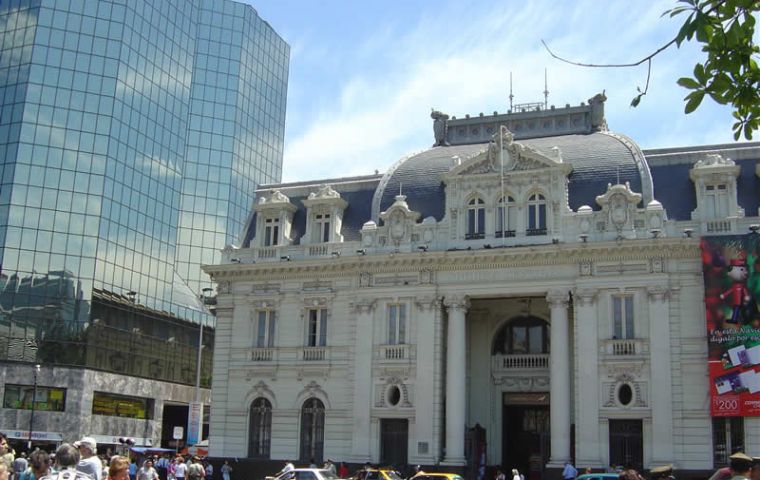MercoPress. South Atlantic News Agency
Chile has the most socio-economic segregated education system of OECD members
 Private schools in Chile receive the most funding from the government
Private schools in Chile receive the most funding from the government The Organization for Economic Co-operation and Development (OECD) names Chile the most socio-economically segregated country regarding education opportunities. The annual report released this week shows that private schools receive the most funding from the government and these schools have the least socioeconomic integration.
The study specifies that the degree of integration of the various socioeconomic backgrounds within a school is less than 50%, whereas the OECD average is 74.8% and top ranked are Finland and Norway with 89%.
Compared to the average OECD private funding for universities, which sits at 8%, Chile provides 21% of private universities’ funding.
The report points out that on average Chile spent 2.707 dollars for each student in primary school and 2.564 dollars for each student in high school which compares dismally with OECD which averages 7.153 and 8.972 dollars respectively.
However when it comes to resources as percentage of a country’s GDP, Chile is above average with 4.2% while the so called ‘club of developed countries’ figures with 3.8%. New Zealand and Denmark with 4.5% and 4.3% are exceptions.
Resources invested in each student doubled comfortably from 1995 to 2008, with the increase particularly intense towards the year 2000. Since then the rhythm of increase has become tepid and is similar to the OECD average of 34%.
The report shows that the percentage of students in universities has expanded significantly, although expenditure in higher education has not kept the pace of GDP expansion.
The 6.829 dollars per university student of 2008 was equivalent to 76% of what was invested in 2000 in constant value. Chile is the country where university students have to finance most of their schooling, 85.4%.
The highest share of this percentage comes from families, 79.3% of total expenditure which means the average Chilean families have to make great sacrifices and face a heavy financial load if they want their children to have access to tertiary education.
In line with the OECD data, Ph.D. in Economics Patricio Meller said that the cost of a university education in Chile is the highest in the world taking into account the country’s GDP and per capita income.




Top Comments
Disclaimer & comment rules-

-

-

Read all comments“Chile has the most socio-economic segregated education system of OECD members” nah, how can this be true??? they are the first world.
Sep 14th, 2011 - 04:16 pm 0xbarilox, we never claimed to be first world, there is way to go to reach that.
Sep 14th, 2011 - 06:35 pm 0What is for sure, is that your comment filled with FIRST CLASS rancorousness reflects third world thinking par excellence.
If you are really interested in the status quo of the education in Chile compared to the OECD members, you can check the official and fresh report here, which will not show such a negatively partial article here (its the trend to beat on the chilean educational system, it sells):
http://www.oecd.org/dataoecd/61/2/48631582.pdf
We are not always on the tail of the meassuring and do several times outpace developped countries in several indicators .
Like for example Austria, Germany in percentage of Population that has attained tertiary education for the group of 25-34 aged)
Or even more exteme outbalancing Austria, Germany, Norway, Luxembourg, UK, Australia, Belgium, Netherlands, New Zealand, Iceland in percentage of Population that has attained tertiary Education for the group of 25-34 aged)
Check this on page 30 and 32.
Interestingly on some studies, they take non-OECD members for comparisons, like Argentina and Brasil. In that cases, we sometimes do really look like first world, even this might not be reality... yet. ;)
So Chilean private schools receive, on average, more state funding than do the state schools, on average.
Sep 14th, 2011 - 08:45 pm 0Seems strange, though not impossible.
Whilst I am not averse to the state topping-up the funds for private schools, everything being equalised (like funding being related to the number of students, teachers, etc) the totality of funding that the state schools individually receive should ALWAYS greatly exceed the individual private top-ups.
One key question is
'how much does a family pay per term/year for their child to attend a private school'?
Another might be
'what percentage of total school costs does parential contribution cover'?
This is a real snake-pit of a Mercopress article.
I think there might be a Mercopress snake in the pit.
Commenting for this story is now closed.
If you have a Facebook account, become a fan and comment on our Facebook Page!